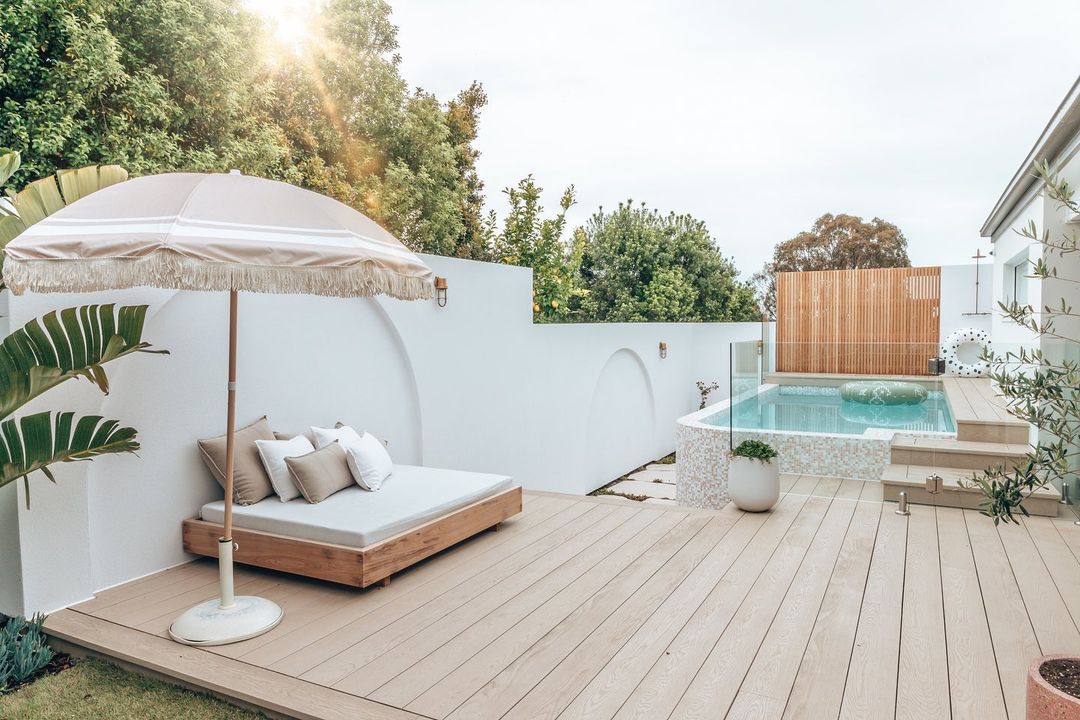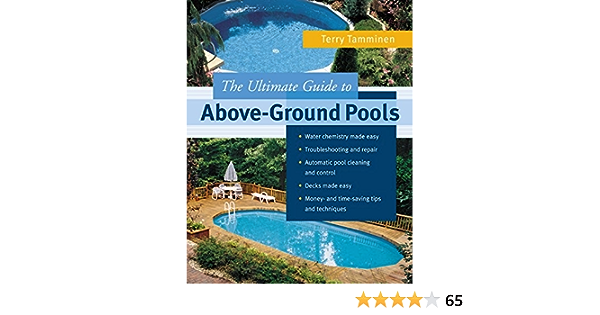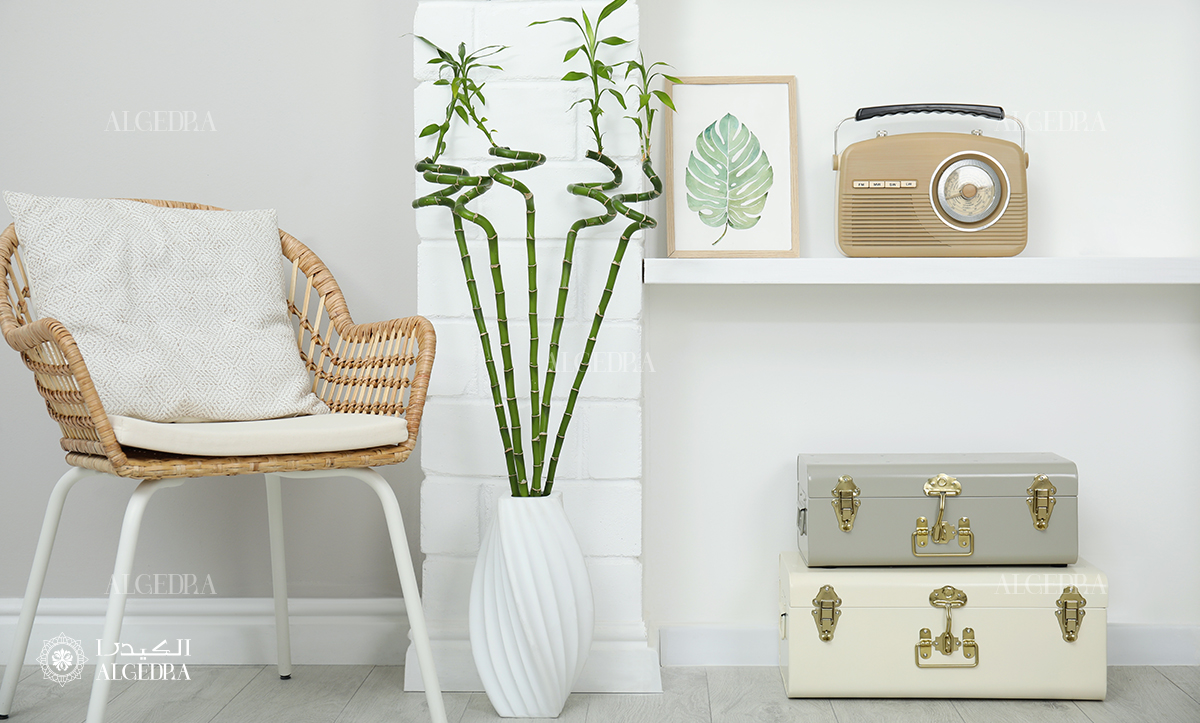In this article, you will discover how to create design harmony by matching your above ground pool with the architecture of your home. By considering factors such as style, materials, and colors, you can seamlessly integrate your pool into your outdoor living space, creating a cohesive and visually pleasing environment. Whether your home boasts sleek modern lines or traditional charm, this guide will provide you with practical tips and inspiration to make your pool an extension of your home’s aesthetic.

Choosing the Right Pool Design
When it comes to choosing the right pool design for your home, there are several factors to consider. The shape and size of the pool are important considerations that will determine how well it fits into your backyard space. Additionally, the material of the pool should be evaluated to ensure its durability and longevity. Finally, reflecting on the pool surroundings will help you create a cohesive and visually appealing outdoor space.
Consider the Shape and Size
The shape and size of your pool should complement the overall design of your home and backyard. If you have a larger yard, you may have more flexibility in choosing a pool shape, such as rectangular, oval, or kidney-shaped. On the other hand, if your yard is smaller, a smaller and more compact pool design would be more appropriate. It’s important to consider the available space and how the pool will fit into the overall layout.
Evaluate the Material
The material of your pool is crucial for its durability and longevity. Common pool materials include fiberglass, concrete, and vinyl. Fiberglass pools are low-maintenance and have a smooth surface that is resistant to algae growth. Concrete pools are highly customizable, allowing you to create your desired shape and design. Vinyl pools are flexible and budget-friendly, but they require periodic liner replacements. Consider the pros and cons of each material to make an informed decision.
Reflect on the Pool Surroundings
When choosing a pool design, it’s essential to reflect on the pool surroundings to ensure a cohesive and visually appealing outdoor space. Consider factors such as landscaping, patio design, and existing structures in your backyard. For example, if your backyard is surrounded by lush greenery, a pool with natural rock elements would blend in beautifully. Reflecting on the pool surroundings will help you create a harmonious and inviting outdoor oasis.
Examining Home Architecture
To achieve design harmony, it’s important to examine the architecture of your home. Analyzing the exterior design, evaluating the building materials, considering the color palette, and assessing the landscape design are all essential in creating a cohesive and visually pleasing outdoor space.
Analyze the Exterior Design
Start by analyzing the exterior design of your home. Is it modern, traditional, or something in between? Look for architectural elements such as rooflines, windows, and entryways that define the style of your home. This will guide you in choosing a pool design that complements the overall aesthetic.
Evaluate the Building Materials
The building materials used in your home’s construction can provide valuable insights for pool design choices. For example, if your home features natural stone accents, incorporating those elements into your pool design can create a seamless transition between your indoor and outdoor spaces. Similarly, if your home is clad in cedar, consider using cedar accents in your pool design to maintain consistency.
Consider the Color Palette
A harmonious color palette is essential in creating a visually appealing outdoor space. Consider the color scheme of your home and choose pool materials, such as tiles or liners, that complement those colors. For example, if your home features warm earth tones, consider a pool design with warm-colored tiles or liners that harmonize with the overall color palette.
Assess the Landscape Design
The landscape design surrounding your home should also be taken into consideration when choosing a pool design. If your landscaping features lush greenery and vibrant flowers, a pool design that incorporates natural elements, such as waterfalls or rock formations, will enhance the visual appeal. On the other hand, if your landscaping is more minimalistic, a sleek and modern pool design may be a better fit.
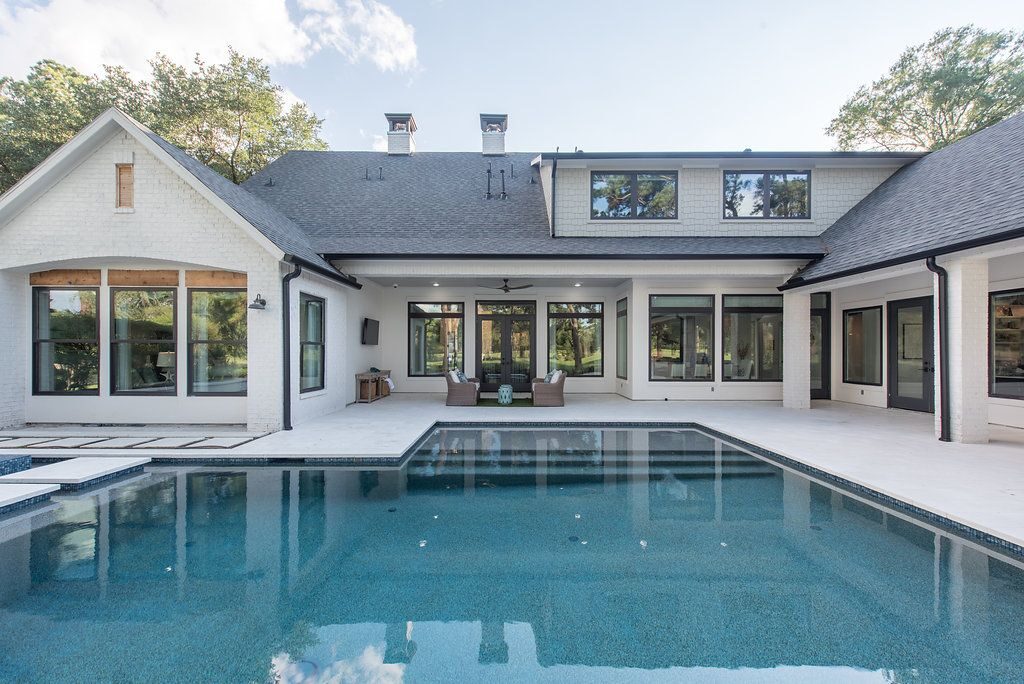
This image is property of foyr.com.

Creating Balance and Continuity
Creating balance and continuity between your pool design and the rest of your outdoor space is key to achieving a cohesive and visually pleasing result. Maintaining consistency in materials, emphasizing complementary shapes, and matching color schemes will help create a harmonious design.
Maintaining Consistency in Materials
Maintaining consistency in the materials used throughout your outdoor space is important to create a seamless transition between the pool and its surroundings. For example, if you have chosen natural stone for your pool, consider using the same stone for the pool deck or patio. This consistency will create a cohesive look and enhance the overall aesthetic.
Emphasizing Complementary Shapes
Emphasizing complementary shapes between your pool and its surroundings can create a sense of continuity and harmony. For instance, if your home features rounded or curvaceous architectural elements, consider incorporating those shapes in your pool design. This can be achieved through rounded pool corners, curved water features, or even a circular pool shape. The key is to echo the shapes found in your home’s architecture to create a visually pleasing design.
Matching Color Schemes
Matching the color schemes between your pool and its surroundings is crucial to creating a harmonious design. Consider the color palette of your home and choose pool materials, such as tiles or liners, that match or complement those colors. This will help tie the pool into the overall aesthetic of your outdoor space, creating a visually pleasing and cohesive design.
Integrating Pool and Deck
Integrating your pool with the surrounding deck is essential in creating a functional and visually appealing outdoor space. Selecting a pool deck material that complements the pool design, coordinating pool and deck size, and ensuring safe and convenient access are key considerations when integrating these two elements.
Select a Pool Deck Material
When selecting a pool deck material, it’s important to choose one that complements the pool design and overall aesthetic. Common pool deck materials include concrete, stone pavers, wood, and composite decking. Each material has its own pros and cons, so consider factors such as durability, maintenance requirements, and aesthetics when making your decision. A well-chosen pool deck material will enhance the overall design and functionality of your outdoor space.
Coordinating Pool and Deck Size
Coordinating the size of your pool and deck is crucial to create a balanced and visually pleasing outdoor space. The pool and deck should not overpower or feel cramped in relation to each other. Take into account the size of your yard, the intended use of the deck space, and the desired capacity of the pool. By carefully coordinating these elements, you can create a seamless and functional integration of the pool and deck.
Ensuring Safe and Convenient Access
Ensuring safe and convenient access to your pool is paramount. Consider factors such as entry points, stairs, and handrails when designing your pool and deck. The placement of these features should be intuitive and easily accessible to ensure the safety of all users. Additionally, consider incorporating non-slip materials on the deck surface and stairs to minimize the risk of accidents. By prioritizing safety and convenience, you can create an enjoyable and worry-free pool experience.

This image is property of images.squarespace-cdn.com.
Enhancing with Landscaping
Incorporating landscaping elements around your pool can enhance the overall visual appeal and create a serene and inviting atmosphere. Choosing plants that complement the pool design, providing adequate privacy, and harmonizing the poolscape with the overall landscape are important considerations when enhancing your outdoor space.
Choosing Plants that Complement
When choosing plants to enhance your pool area, consider their size, growth habits, and compatibility with water and chlorine exposure. Opt for plants that complement the pool design and surrounding landscape. For example, if your pool has a tropical theme, consider adding palm trees or lush foliage. If you prefer a more minimalist design, choose low-maintenance ornamental grasses or succulents. The right mix of plants will enhance the overall aesthetic and create a harmonious and inviting poolside oasis.
Providing Adequate Privacy
Creating a sense of privacy around your pool area is essential for a relaxing and enjoyable experience. Consider using tall hedges, strategically placed trees, or privacy screens to shield your pool from prying eyes. This will create a more intimate and secluded space for you and your family to enjoy. Additionally, privacy features can also help reduce wind and noise, creating a more peaceful and serene environment.
Harmonizing Poolscape and Landscape
Harmonizing the poolscape with the overall landscape is crucial in creating a visually cohesive design. Consider the existing landscape elements and choose pool materials, such as tiles or coping, that complement or match the surrounding environment. Incorporate plants and hardscape features that flow seamlessly from the pool area into the rest of the landscape. By harmonizing the poolscape with the overall landscape, you can create a visually pleasing and integrated outdoor space.
Considering Safety Measures
Prioritizing safety when designing your pool area is of utmost importance. Adhering to local building codes, installing safety barriers, and ensuring proper lighting are key considerations to create a safe and secure environment for everyone.
Adhering to Local Building Codes
When designing your pool area, it’s essential to adhere to local building codes and regulations. These codes may dictate requirements such as fence height, gate placement, and drain safety. By following these guidelines, you can ensure the safety and compliance of your pool area. Consult with local authorities or a professional pool designer to ensure that your pool design meets all necessary requirements.
Installing Safety Barriers
Installing safety barriers around your pool is crucial, especially if you have young children or pets. Pool fences, safety covers, and alarm systems can help prevent accidents and provide an additional layer of security. Consider the height, material, and design of the safety barriers to ensure they are effective in preventing unsupervised access to the pool. Remember, safety should be a top priority when designing your pool area.
Ensuring Proper Lighting
Proper lighting is essential for both safety and ambiance. Consider installing adequate lighting in and around your pool area to ensure visibility during nighttime use. Pool lights, pathway lights, and landscape lighting can all contribute to a well-lit and secure environment. Additionally, well-placed lighting fixtures can enhance the beauty and aesthetics of your pool area, creating a welcoming and inviting atmosphere.
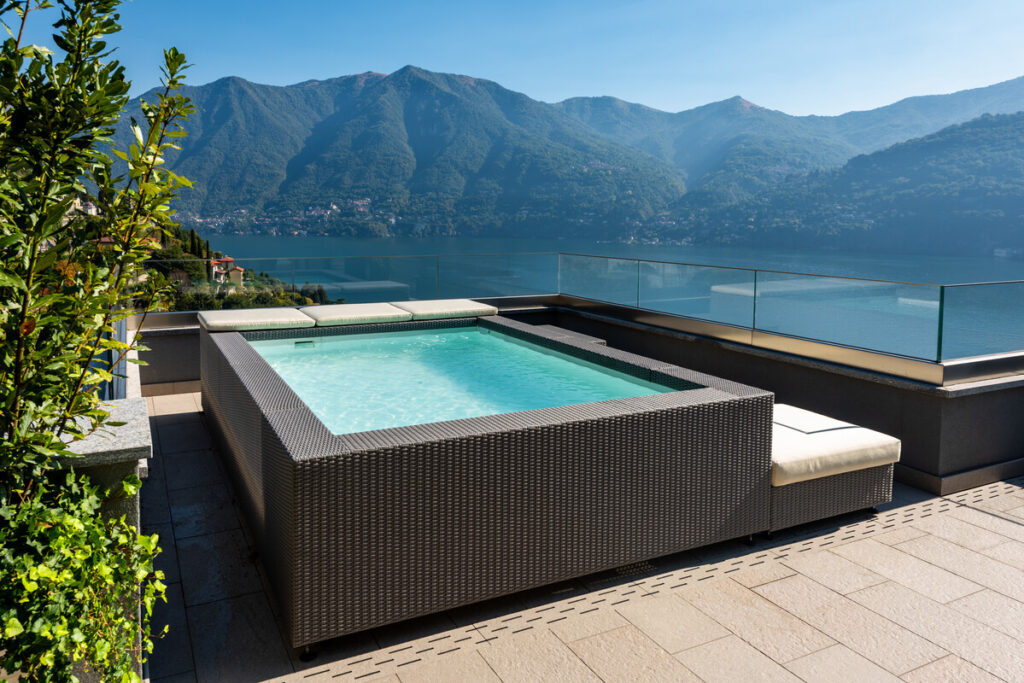
This image is property of www.fluidra.com.
Optimizing Pool Placement
Optimizing the placement of your pool is important for both practical and visual reasons. Analyzing sun exposure, considering wind direction, and maintaining visual appeal are all factors to consider when determining the optimal location for your pool.
Analyzing Sun Exposure
Analyzing the sun exposure of your backyard is crucial when determining the placement of your pool. Consider where the sun rises and sets, as well as any existing shade structures or trees that may affect the amount of sunlight your pool area receives. Placing the pool in an area with optimal sun exposure will ensure enjoyable swimming conditions and help maintain the water temperature.
Considerations for Wind Direction
Wind direction is another important factor to consider when optimizing pool placement. A pool located in a windy area can result in discomfort and evaporation, as well as create challenges in maintaining water cleanliness. Take note of the prevailing wind patterns in your area and consider placing the pool in a location that is sheltered from strong winds. This will help create a more pleasant pool environment and reduce maintenance requirements.
Maintaining Visual Appeal
While practical considerations like sun exposure and wind direction are important, maintaining visual appeal is also key. Your pool should be a focal point in your backyard, so consider its placement in relation to your home and existing landscape features. Choose a location that provides a visually pleasing backdrop and enhances the overall aesthetics of your outdoor space. By finding the perfect balance between practicality and visual appeal, you can optimize the placement of your pool.
Incorporating Design Elements
Incorporating design elements into your pool area can take it from ordinary to extraordinary. Adding water features, integrating pool accessories, and exploring pool lighting options are fantastic ways to enhance the overall design and create a captivating outdoor space.
Adding Water Features
Water features such as waterfalls, fountains, or spillover spas can add a touch of luxury and serenity to your pool area. The soothing sound of running water and the visual interest they provide can greatly enhance the experience of your pool. Consider the style and scale of your pool, as well as the overall aesthetic of your outdoor space, when choosing a water feature. Whether you opt for a small trickling fountain or a grand waterfall, incorporating water features will elevate the design of your pool area.
Integrating Pool Accessories
Integrating pool accessories is an excellent way to add both functionality and personality to your pool area. Consider accessories such as pool loungers, umbrellas, poolside bars, or even a built-in outdoor kitchen. These additions will not only enhance the usability of your pool area but also create a fun and inviting atmosphere for entertaining. Choose accessories that match the overall design aesthetic and reflect your personal style.
Exploring Pool Lighting Options
Pool lighting is not only important for safety but also for creating a captivating ambiance. Explore different pool lighting options such as underwater lights, fiber optic lighting, or LED strip lighting. These options can be used to highlight architectural features, create a magical nighttime atmosphere, or simply provide sufficient lighting for nighttime swimming. By carefully selecting and integrating pool lighting, you can elevate the overall design and create a breathtaking outdoor space.
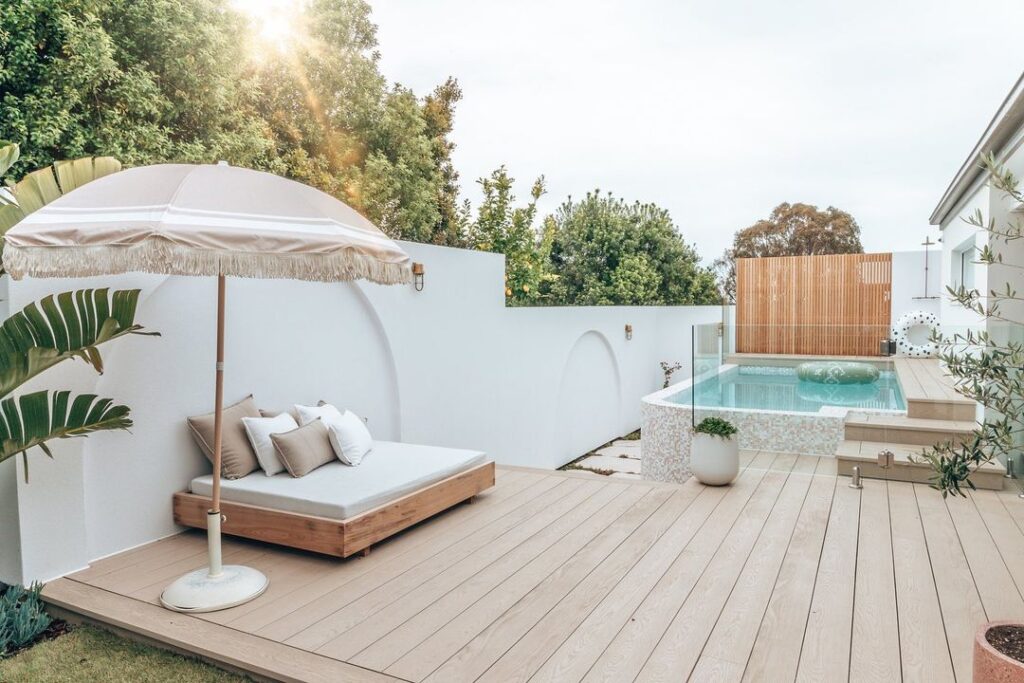
This image is property of www.thespruce.com.
Considering Maintenance and Upkeep
Considering maintenance and upkeep requirements is essential when designing your pool area. Choosing low-maintenance materials, designing for easy cleaning, and planning for repairs and renovations can help ensure a hassle-free and enjoyable experience.
Choosing Low-Maintenance Materials
When selecting materials for your pool and pool area, opt for low-maintenance options. For example, fiberglass pools are known for their low-maintenance characteristics, requiring minimal upkeep and cleaning. Additionally, choose decking materials, such as composite or concrete, that are resistant to stains, fading, and cracking. By choosing low-maintenance materials, you can minimize the time and effort required for pool upkeep.
Designing for Easy Cleaning
Designing your pool area with easy cleaning in mind will save you time and effort in the long run. Consider features such as built-in cleaning systems, efficient filtration systems, and easy-to-access water testing and treatment areas. Additionally, incorporating proper drainage systems, skimmers, and leaf traps will help keep your pool clean and free from debris. By designing for easy cleaning, you can maintain a sparkling and inviting pool with minimal effort.
Planning for Repairs and Renovations
Planning for repairs and renovations is crucial for the long-term upkeep and enjoyment of your pool area. Consider factors such as access to plumbing and electrical systems, as well as the ease of replacing pool liners or resurfacing the pool. By making these considerations during the design phase, you can ensure that future repairs and renovations can be carried out efficiently and without major disruptions to your pool area.
Seeking Professional Advice
Designing your pool area to perfectly match your home architecture and personal style may require the expertise of professionals. Consulting with architects, engaging pool designers, and utilizing professional landscapers can help bring your vision to life and ensure a successful and harmonious outdoor space.
Consulting with Architects
If you’re seeking a tailored pool design that seamlessly integrates with your home architecture, consulting with architects is an excellent choice. Architects can analyze your home’s design, assess your specific needs and preferences, and create a cohesive and visually appealing pool design that perfectly complements your home. Their expertise and attention to detail will ensure a harmonious and functional outdoor space.
Engaging Pool Designers
Engaging pool designers can be incredibly beneficial when creating your dream pool area. Pool designers specialize in pool layout, materials, and aesthetics, ensuring that your pool design is not only visually stunning but also functional and trouble-free. They can guide you through the design and construction process, help you make informed decisions, and ensure that your pool area meets all safety and regulatory requirements. With their expertise, you can achieve a pool design that perfectly matches your home architecture and personal preferences.
Utilizing Professional Landscapers
Professional landscapers are experienced in creating harmonious outdoor spaces that blend seamlessly with your home architecture and pool design. They can help choose the right plants, create a cohesive landscape design, and provide the necessary expertise for proper installation and maintenance. By utilizing professional landscapers, you can ensure that your pool area is enhanced by stunning landscaping, creating a truly beautiful and inviting outdoor oasis.
In conclusion, choosing the right pool design involves considering the shape and size, evaluating the material, and reflecting on the pool surroundings. Examining the home architecture includes analyzing the exterior design, evaluating the building materials, considering the color palette, and assessing the landscape design. Creating balance and continuity requires maintaining consistency in materials, emphasizing complementary shapes, and matching color schemes. Integrating the pool and deck involves selecting a pool deck material, coordinating the pool and deck size, and ensuring safe and convenient access. Enhancing with landscaping encompasses choosing plants that complement, providing adequate privacy, and harmonizing the poolscape with the landscape. Considering safety measures involves adhering to local building codes, installing safety barriers, and ensuring proper lighting. Optimizing pool placement requires analyzing sun exposure, considering wind direction, and maintaining visual appeal. Incorporating design elements includes adding water features, integrating pool accessories, and exploring pool lighting options. Considering maintenance and upkeep involves choosing low-maintenance materials, designing for easy cleaning, and planning for repairs and renovations. Finally, seeking professional advice by consulting with architects, engaging pool designers, and utilizing professional landscapers can help bring your pool design to life and ensure a successful and harmonious outdoor space. By following these considerations and incorporating your own personal style, you can create the perfect pool area that beautifully complements your home architecture.

